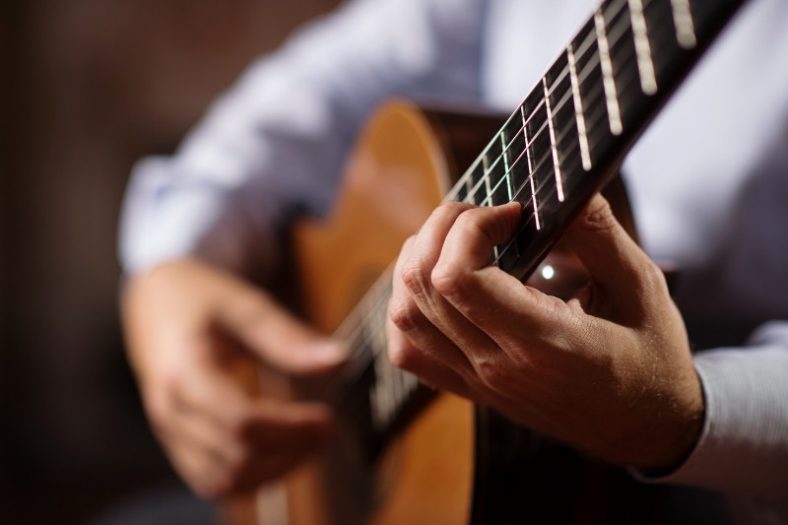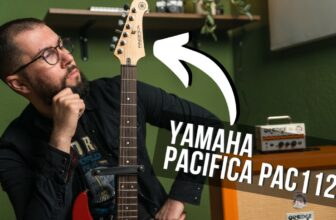What is Fingerstyle Guitar?

“Fingerstyle” guitar involves various styles based on playing with the fingertips, nails, or fingerpicks. “Fingerpicking” is another term that is often used in the same way as fingerstyle. With the right hand’s fingertips, you play the strings on the guitar.
Contents
- How Hard is Fingerstyle Guitar?
- Is Fingerstyle Harder than Normal Style?
- Is Fingerstyle Guitar Exclusively Classical?
- Can You Play Fingerstyle on an Electric Guitar?
- Guitar Pick or Fingerstyle?
- Are Fingerstyle and Fingerpicking the Same?
- How to Improve Your Fingerstyle?
- What’s the Best Guitar for Fingerstyle?
- Summary
How Hard is Fingerstyle Guitar?
Fingerstyle guitar is hard during the beginning but is doable with the right methods and practice.
The beginning process is especially hard due to the wide variety of available techniques. In the absence of a supporting foundation of fingerstyle arpeggios and chords with shifting dynamics, it is difficult.
Learning to play fingerstyle guitar will broaden your horizons. You won’t be reliant on a traditional technique taught by a teacher. Starting with simple songs and working your way up to more complex ones is the best way to learn.
Before attempting to play fingerstyle, you should first learn how to play in the normal style. This technique necessitates practicing the right-hand technique. This involves playing fingerstyle patterns while listening to a metronome. A richer, more complex sound is achieved when combining different musical parts in real-time.
As you use right-hand fingers for this technique, another difficulty is developing calluses. This means having your right-hand fingers peeled until your skin gets thicker. This can be painful if you don’t take pauses while practicing. To prevent their nails from cracking and peeling from repeated use, some guitarists use acrylic nails or thumb picks. It also makes a difference in how the notes sound.
Fingerstyle guitar is one of the most interesting ways to play the guitar. You can play chords, melodies, a lot of different rhythmic patterns, and other things with this technique.
Is Fingerstyle Harder than Normal Style?
Fingerstyle is not necessarily harder than the normal style of playing guitar. It’s great to learn how to play both.
For most guitar teachers, it’s better to learn the fingerstyle after the normal style. But this is not because the fingerstyle is the harder one.
When it comes to the term “fingerstyle,” the music and the technique used tend to be more folk-based. To play fingerstyle, you use your right hand’s fingers instead of a pick or flat pickup plectrum. For some, this may be a facilitating feature while for some, it is the opposite.
In folk and pop music, the arrangements will consist of a single vocal melody with some accompanying instrumentation. It’s usually learned on one’s own, and even if one does take lessons, there isn’t a lot of attention to technique.
When a technique is open to being self-taught, it definitely gives a lighter feeling. The basics of the fingerstyle are all about hearing what you’re playing. It’s also generally learned using a tab if there’s any written music involved.
Knowing these factors may help you to decide if the fingerstyle is harder than the normal style or not.
Is Fingerstyle Guitar Exclusively Classical?
Fingerstyle guitar, today, is mostly classical, referring to what kind of guitar you use.
I want to make it clear because there are two options when you use these two terms. If we go deep into these two terms, fingerstyle and classical are two difficult concepts to grasp. Because the terms “classical” and “fingerstyle” are both interbedded.
In this case, there are two possibilities. Classical is one of the fingerstyle techniques. Or, you can use the fingerstyle technique through the classical style on a guitar. To be more clear, for example, the fingerstyle approach is also used in the playing of the banjo.
It is common for the fingerstyle technique to be performed on a steel-string guitar. Metal strings are widely employed in the classical style of classical guitar.
Can You Play Fingerstyle on an Electric Guitar?
Fingerstyle on an electric guitar is like applying the technique to an acoustic guitar. But, you don’t have as many possibilities for percussion as you have on the acoustic instrument.
The strings of an electric guitar don’t hurt your fingers as much as they do on an acoustic. But, while playing fingerstyle on an acoustic guitar, the tone is far superior to that of an electric one.
Additionally, many electric guitars have low action to allow shredding. You may find applying fingerstyle more comfortable on an electric guitar. Your fingers will have more control over tone and attack when you play with bare hands. It’s good to keep in mind that it may result in fret buzz while performing specific fingerstyle patterns.
Guitar Pick or Fingerstyle?
Many beginners want to know which is better to learn first.
In the beginning stages, most guitarists use a pick before moving on to more advanced right-hand techniques. Hybrid picking, thumb picking, or fingerpicking are some examples. Even playing with the right-hand fingers in the fingerstyle guitar is another example.
Additionally, this method of playing guitar differs from “Flatpicking”. This means playing notes with a plectrum attached to the index finger (flat pick), or the practice of strumming the strings of the guitar in chords.
Are Fingerstyle and Fingerpicking the Same?
Fingerstyle and fingerpicking are basically the same. “Fingerpicking” is usually considered as another way to say “fingerstyle. But it is more complicated than that. Fingerstyle is a technique that involves various styles and fingerpicking is one of them. This includes various finger patterns. This is why fingerpicking is also called pattern picking or thumb picking.
These patterns are also used in other styles of fingerstyle techniques like classical, jazz, and flamenco. This explains why these two terms are used in the same way. Because you apply any kind of fingerstyle by fingerpicking.
How to Improve Your Fingerstyle?
There are exercises on the internet – practice makes perfect. Many exercises focus on different finger-picking patterns that you might need.
Here, I want to share some practical tips from a guitarist and guitar teacher, Matt Warnock. These tips can help you to understand the logic of practicing fingerstyle. You can also apply these exercises to any kind of guitar from jazz to folk, pop, or even classical. For more detailed courses and other information about the guitar, check it out here.
If you are a classical guitarist and you have hesitations about the fingerstyle, I recommend you check out this video for some tips.
In your first fingerstyle exercise, let the bassline of any chosen chord sequence you’re playing get all the attention. You’ll play first the bass line and then the chord.
The next practice is kind of reversing the first exercise. You’ll play the chord first, and then the bass. The point is still to keep the chord and the bass separate like in the first exercise. You can also mix these two exercises to get more used to the differences.
You’ll pick a melody and you’ll continue to do a similar exercise by focusing on the melody separate from the chord. You can also reverse the third exercise, first playing the chord and then the melody. Keeping the attention on the melody line while separating the chord creates the illusion of two guitarists playing.
Another option is very interesting. Matt has seen piano players practice this exercise, so he decided to adapt it for the guitar. The outer two notes of each chord will be played first, followed by the inner two notes. Then again, you reverse it first playing the inner two notes and then the outer two notes of each chord.
After getting used to the multi-note techniques, you should practice ascending arpeggio and descending arpeggio exercises. This will provide you the finger independence and melodic material for your jams.
Finally, you should practice descending chords and then melody. After that, first playing a melody and then ascending chords will effectively improve your technique.
What’s the Best Guitar for Fingerstyle?
A classical guitar is most suitable for fingerstyle.
A classical guitar is typically made with nylon strings which deform the fingers less than metal strings. They are more flexible.
Summary
Fingerstyle guitar is an advanced technique that will increase your skills and musicality. Fingerstyle is the name of the whole technique. Fingerpicking is indicating the finger patterns involved in various styles of the technique.
A classical guitar is the best choice for your fingers’ sake especially if you are a beginner. But you can apply this technique even on an electric guitar. With some research, you can find various methods and exercises on the internet only with a click. As always in music, practicing is the key.





